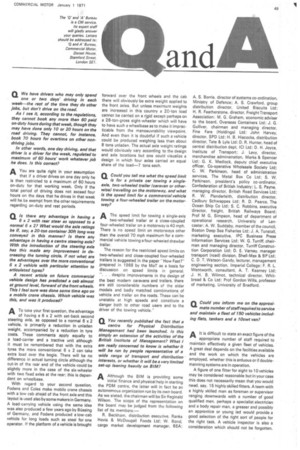• Is there any advantage in having a 6 x
Page 51

If you've noticed an error in this article please click here to report it so we can fix it.
2 with rear steer as opposed to a normal 6 x 2? What would the axle ratings be if, say, a 20-ton container 30ft long was conveyed in this manner? Is there any advantage in having a centre steering axle? With the introduction of the steering axle has this made any improvement in decreasing the turning circle, if not what are the advantages over the more conventional 6 x 2 vehicle with particular attention to articulated types?
A recent article on future commercial vehicle design has predicted a cab almost at ground level, forward of the front wheels. This I feel sure was done some time ago on a mobile crane chassis. Which vehicle was this, and was it produced?
ATo take your first question, the advantage of having a 6 x 2 with set-back second steering axle, as opposed to a normal 6 x 2 vehicle, is primarily a reduction in unladen weight, accompanied by a reduction in tyre costs. These comments apply equally to a load-carrier and a tractive unit although it must be remembered that with the extra tyres the more conventional 6 x 2 can take extra load over the bogie. There will be no difference in actual turning circle although the cut-in of the rear end of the vehicle could be slightly more in the case of the six-wheeler with two fixed axles at the rear; this is dependent on wheelbase.
With regard to your second question, Fodens and Coles make mobile crane chassis with a low cab ahead of the front axle and this layout is used also by some makers in Germany. A load-carrying vehicle using the same idea was also produced a few years ago by Bussing of Germany, and Fodens produced a low-cab vehicle for long loads such as steel for one operator. If the platform of a vehicle is brought forward over the front wheels and the cab there will obviously be extra weight applied to the front axles. But unless maximum weights are increased in this country a 20-ton load cannot be carried on a rigid except perhaps on a 28-ton-gross eight-wheeler which will have to have such a wheelbase as to make it impracticable from the manoeuvrability viewpoint. And even then it is doubtful if such a vehicle could be produced weighing less than about 8 tons unladen. The actual axle weight ratings would obviously vary according to the design and axle locations but one could visualize a design in which four axles carried an equal share of the load-7 tons each.




















































































